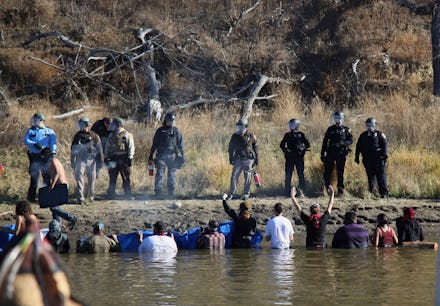Standing Rock protesters are getting help from thousands of veterans as "human shields"

Nearly 2,000 veterans have pledged to stand with Standing Rock, acting as "human shields" for those protesting the construction of the Dakota Access pipeline, the New York Times reported Tuesday.
The group, Veterans Stand for Standing Rock, offered its services one day after the U.S. Army Corps of Engineers told the Standing Rock Sioux Tribe to abandon its ongoing demonstration against the project and North Dakota Gov. Jack Dalrymple announced a "mandatory evacuation" of the protesters' main camp.
"If the cops there want to be state sanctioned agents to brutally beat non-violent veterans that have served their country honorably, if they're gonna beat us, then that should be the signal to the rest of the world what our country is doing," co-organizer Michael A. Wood, a former Marine and Baltimore police officer, said in a video for Now This.
"If there was one group in this country that adequately and thoroughly represents the military, it is the Native American people," he said.
Protesters say construction of the pipeline, which would transport around 500,000 barrels of crude oil across four states each day, would not only pollute a major water source, the Missouri River, but disturb ancestral burial and prayer sites.
In September, President Barack Obama moved to halt the pipeline's construction while his administration investigates its potential for environmental damage. But with Obama's set to hand the baton to President-elect Donald Trump, who owns stock in the company building the pipeline, it seems likely that construction will be completed.
According to the group's GoFundMe page, they've exceeded their 2,000-person capacity for participation in the protest, far beyond the 500 people Wood told the Times he'd originally expected. The event is slated to begin one day before the Corps of Engineers says it will block access to "Corps-managed federal property north of the Cannonball River" on Dec. 5, cordoning off land south of the river as a "free speech zone."
Both the Corps of Engineers and the governor have cited hazardous weather conditions as a reason for removing protesters from the site, but the more pressing driver would seem to be what the Corps called "violent confrontations" between police and the non-violent protesters. Authorities have used rubber bullets and water cannons on demonstrators in below-freezing temperatures; they have deployed pepper spray and tear gas to disperse the water protecters. One protester, Sophia Wilansky, might lose her arm after police allegedly hit her with a grenade.
Lt. Thomas Iverson, North Dakota State Highway Patrol spokesperson, told the Times authorities are "aware" of Veterans for Standing Rock's plans.
"If the group remains lawful and refrains from blocking the roadway, there will be no issues," he said.
But if past months are any indication, "issues" are to be expected.
Correction: Nov. 30, 2016